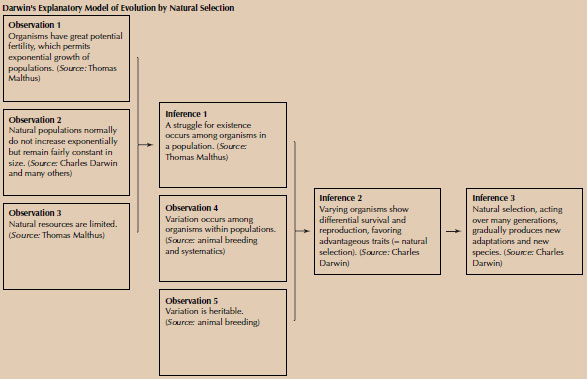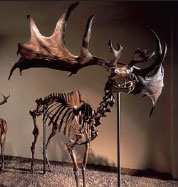Natural Selection
Natural Selection
Natural selection is the centerpiece of Darwin’s theory of evolution. It gives us a natural explanation for the origins of adaptation, including all developmental, behavioral, anatomical, and physiological attributes that enhance the organism’s ability to use environmental resources to survive and to reproduce. Darwin developed his theory of natural selection as a series of five observations and three inferences drawn from them:
Observation 1—Organisms
have great potential fertility. All
populations produce large numbers
of gametes and potentially large numbers
of offspring each generation.
Population size would increase exponentially
at an enormous rate if all
individuals that were produced each
generation survived and reproduced.
Darwin calculated that, even in slowbreeding
animals such as elephants, a
single pair breeding from age 30 to 90
and having only six young could
produce 19 million descendants in
750 years.
Observation 2—Natural populations normally remain constant in size, except for minor fluctuations. Natural populations fluctuate in size across generations and sometimes go extinct, but no natural populations show the continued exponential growth that their reproductive biology theoretically could sustain.
Observation 3—Natural resources are limited. Exponential growth of a natural population would require unlimited natural resources to provide food and habitat for the expanding population, but natural resources are finite.
Inference 1—A continuing struggle for existence exists among members of a population. Survivors represent only a part, often a very small part, of the individuals produced each generation. Darwin wrote in The Origin of Species that “it is the doctrine of Malthus applied with manifold force to the whole animal and vegetable kingdoms.” The struggle for food, shelter, and space becomes increasingly severe as overpopulation develops.
Observation 4—All organisms show variation. No two individuals are exactly alike. They differ in size, color, physiology, behavior, and many other ways.
Observation 5—Some variation is heritable. Darwin noted that offspring tend to resemble their parents, although he did not understand how. The hereditary mechanism discovered by Gregor Mendel would be applied to Darwin’s theory many years later.
Inference 2—There is differential survival and reproduction among varying organisms in a population. Survival in the struggle for existence is not random with respect to hereditary variation present in the population. Some traits give their possessors an advantage in using the environment for effective survival and reproduction.
Inference 3—Over many generations, differential survival and reproduction generates new adaptations and new species. The differential reproduction of varying organisms gradually transforms species and results in the long-term “improvement” of types. Darwin knew that people often use hereditary variation to produce useful new breeds of livestock and plants. Natural selection acting over millions of years should be even more effective in producing new types than the artificial selection imposed during a human lifetime. Natural selection acting independently on geographically separated populations would cause them to diverge from each other, thereby generating reproductive barriers that lead to speciation.
The popular phrase “survival of the fittest” was not originated by Darwin but was coined a few years earlier by the British philosopher Herbert Spencer, who anticipated some of Darwin’s principles of evolution. Unfortunately the phrase later came to be coupled with unbridled aggression and violence in a bloody, competitive world. In fact, natural selection operates through many other characteristics of living organisms. The fittest animal may be one that enhances the living conditions of its population. Fighting prowess is only one of several means toward successful reproductive advantage.
Natural selection can be viewed as a two-step process with a random component and a nonrandom component. Production of variation among organisms is the random component. The mutational process does not preferentially generate traits that are favorable to the organism; if anything, the reverse is probably true. The nonrandom component is the survival of different traits. This differential survival is determined by the effectiveness of different traits in permitting their possessors to use environmental resources to survive and to reproduce. The phenomenon of differential survival and reproduction among varying organisms is now called sorting and should not be equated with natural selection. We now know that even random processes (genetic drift) can produce sorting among varying organisms. Selection states that sorting occurs because certain traits give their possessors advantages in survival and reproduction relative to others that lack those traits. Selection is therefore a specific cause of sorting.
Darwin’s theory of natural selection
has been challenged repeatedly. One
challenge claims that directed (nonrandom)
variation governs evolutionary
change. In the decades around 1900,
diverse evolutionary hypotheses collectively
called orthogenesis proposed
that variation has momentum that
forces a lineage to evolve in a particular
direction that is not always adaptive.
The extinct Irish elk was a popular
example of orthogenesis. Newly produced
variation was considered biased
toward increasing the size of their
antlers, thereby generating an evolutionary
momentum for producing larger
antlers. Natural selection was considered
ineffective at stopping the antlers
eventually from becoming so large and
cumbersome that they forced the Irish
elk into extinction (Figure 6-26). Orthogenesis
explained apparently nonadaptive
evolutionary trends that forced
species into decline. Subsequent
genetic research on the nature of variation,
however, has rejected the genetic
predictions of orthogenesis.
Another recurring criticism of natural selection is that it cannot generate new structures or species but can only modify old ones. Most structures in their early evolutionary stages could not have performed the biological roles that the fully formed structures perform, and it is therefore unclear how natural selection could have favored them. What use is half a wing or the rudiment of a feather for a flying bird? To answer this criticism, we propose that many structures evolved initially for purposes different from the ones they have today. Rudimentary feathers could have been useful in thermoregulation, for example. The feathers later became useful for flying after they incidentally acquired some aerodynamic properties. Natural selection then could act to improve the usefulness of feathers for flying. Because structural changes that separate members of different species are similar in kind to those that we observe within species, it is reasonable to propose that selection can lead beyond the species boundary.
Natural selection is the centerpiece of Darwin’s theory of evolution. It gives us a natural explanation for the origins of adaptation, including all developmental, behavioral, anatomical, and physiological attributes that enhance the organism’s ability to use environmental resources to survive and to reproduce. Darwin developed his theory of natural selection as a series of five observations and three inferences drawn from them:
 |
Observation 2—Natural populations normally remain constant in size, except for minor fluctuations. Natural populations fluctuate in size across generations and sometimes go extinct, but no natural populations show the continued exponential growth that their reproductive biology theoretically could sustain.
Observation 3—Natural resources are limited. Exponential growth of a natural population would require unlimited natural resources to provide food and habitat for the expanding population, but natural resources are finite.
Inference 1—A continuing struggle for existence exists among members of a population. Survivors represent only a part, often a very small part, of the individuals produced each generation. Darwin wrote in The Origin of Species that “it is the doctrine of Malthus applied with manifold force to the whole animal and vegetable kingdoms.” The struggle for food, shelter, and space becomes increasingly severe as overpopulation develops.
Observation 4—All organisms show variation. No two individuals are exactly alike. They differ in size, color, physiology, behavior, and many other ways.
Observation 5—Some variation is heritable. Darwin noted that offspring tend to resemble their parents, although he did not understand how. The hereditary mechanism discovered by Gregor Mendel would be applied to Darwin’s theory many years later.
Inference 2—There is differential survival and reproduction among varying organisms in a population. Survival in the struggle for existence is not random with respect to hereditary variation present in the population. Some traits give their possessors an advantage in using the environment for effective survival and reproduction.
Inference 3—Over many generations, differential survival and reproduction generates new adaptations and new species. The differential reproduction of varying organisms gradually transforms species and results in the long-term “improvement” of types. Darwin knew that people often use hereditary variation to produce useful new breeds of livestock and plants. Natural selection acting over millions of years should be even more effective in producing new types than the artificial selection imposed during a human lifetime. Natural selection acting independently on geographically separated populations would cause them to diverge from each other, thereby generating reproductive barriers that lead to speciation.
The popular phrase “survival of the fittest” was not originated by Darwin but was coined a few years earlier by the British philosopher Herbert Spencer, who anticipated some of Darwin’s principles of evolution. Unfortunately the phrase later came to be coupled with unbridled aggression and violence in a bloody, competitive world. In fact, natural selection operates through many other characteristics of living organisms. The fittest animal may be one that enhances the living conditions of its population. Fighting prowess is only one of several means toward successful reproductive advantage.
Natural selection can be viewed as a two-step process with a random component and a nonrandom component. Production of variation among organisms is the random component. The mutational process does not preferentially generate traits that are favorable to the organism; if anything, the reverse is probably true. The nonrandom component is the survival of different traits. This differential survival is determined by the effectiveness of different traits in permitting their possessors to use environmental resources to survive and to reproduce. The phenomenon of differential survival and reproduction among varying organisms is now called sorting and should not be equated with natural selection. We now know that even random processes (genetic drift) can produce sorting among varying organisms. Selection states that sorting occurs because certain traits give their possessors advantages in survival and reproduction relative to others that lack those traits. Selection is therefore a specific cause of sorting.
 |
| Figure 6-26 The Irish elk, a fossil species that once was used to support the orthogenetic idea that momentum in variation caused the antlers to become so large that the species was forced into extinction. |
Another recurring criticism of natural selection is that it cannot generate new structures or species but can only modify old ones. Most structures in their early evolutionary stages could not have performed the biological roles that the fully formed structures perform, and it is therefore unclear how natural selection could have favored them. What use is half a wing or the rudiment of a feather for a flying bird? To answer this criticism, we propose that many structures evolved initially for purposes different from the ones they have today. Rudimentary feathers could have been useful in thermoregulation, for example. The feathers later became useful for flying after they incidentally acquired some aerodynamic properties. Natural selection then could act to improve the usefulness of feathers for flying. Because structural changes that separate members of different species are similar in kind to those that we observe within species, it is reasonable to propose that selection can lead beyond the species boundary.




